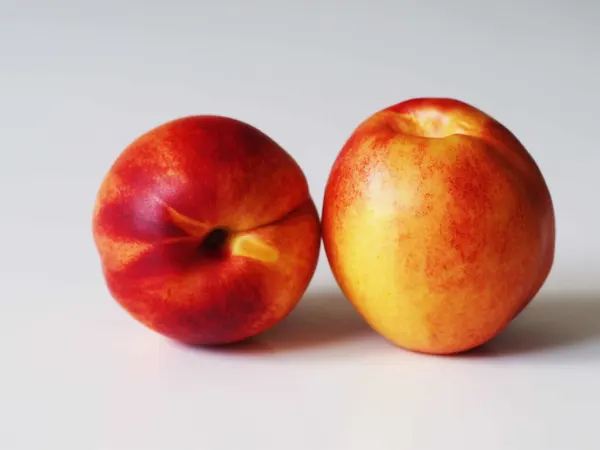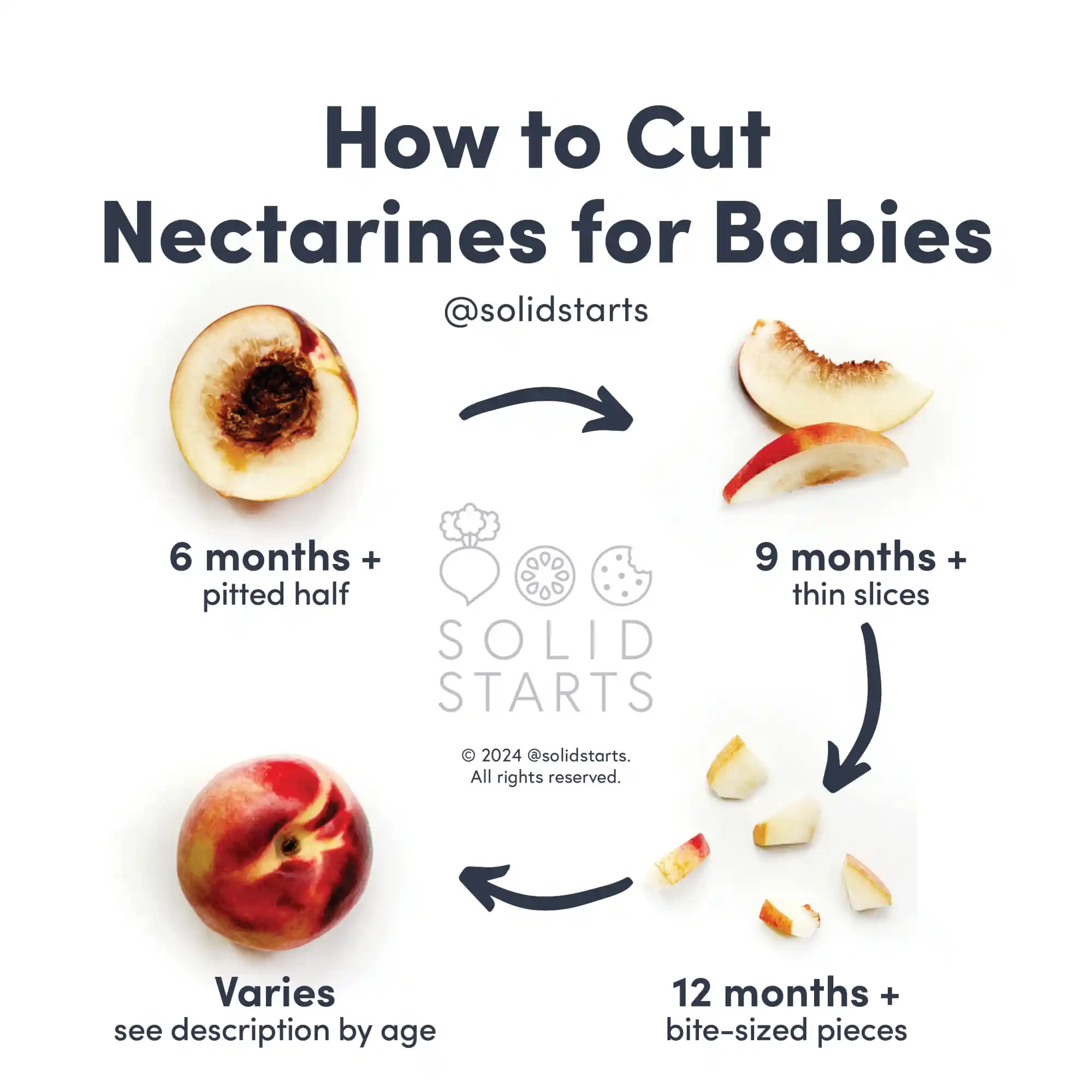Nectarine
Fruit
Age Suggestion
6 months
Iron-Rich
No
Common Allergen
No

When can babies have nectarines?
Nectarines may be introduced as soon as baby is ready to start solids, which is generally around 6 months of age, as long as the fruit is very soft and ripe or cooked until soft.
Nectarines and peaches share nearly all of the same genetic make-up, with one exception. While peaches grow a fuzzy skin, the skin of a nectarine is smooth and glossy. Sometimes a nectarine will even grow on a tree full of peaches, and vice versa. Both peach and nectarine were first cultivated in East Asia thousands of years ago.
Are nectarines healthy for babies?
Yes. Nectarines offer carbohydrates, fiber, and fluid, in addition to potassium and vitamins A, C, E, and K. Together, these nutrients help provide energy to fuel crawling and exploration, support the digestive system, and keep baby hydrated. They also help to support electrolyte balance, skin health, vision, iron absorption, immune function, and blood clotting. Nectarines are among the fruits that are particularly helpful for babies struggling with constipation.
Are nectarines a common allergen?
No. Allergies to nectarines are uncommon. Individuals with Oral Allergy Syndrome (also known as pollen-food allergy syndrome), and particularly those with sensitivities to birch tree and/or certain grass pollens, may be sensitive to nectarines. Individuals sensitive to other foods of the Rosaceae family, such as apricots, almonds, peaches, and plums may also have a similar experience with nectarines. Oral Allergy Syndrome typically results in short-lived itching, tingling, or burning in the mouth and is unlikely to result in a dangerous reaction. Cooking, canning, or peeling nectarines can help minimize and even eliminate the reaction.
As you would when introducing any new food, start by offering a small quantity on its own for the first few servings. If there is no adverse reaction, gradually increase the quantity over future meals.
Are nectarines a choking hazard for babies?
Yes. Nectarines, especially when underripe, are slippery and can be firm, qualities that increase the risk of choking. To reduce the risk, prepare and serve nectarines in an age-appropriate way. As always, make sure you create a safe eating environment and stay within an arm’s reach of baby during meals.
Learn the signs of choking and gagging and more about choking first aid in our free guides, Infant Rescue and Toddler Rescue.
Videos
When can babies drink nectarine juice?
Wait to serve nectarine juice as a drink until after 12 months of age. Note that it can be beneficial to wait until a child is older to regularly share juice and other sugary drinks. Research suggests that regular intake of juice and other sweet drinks tends to increase the risk of dental cavities and take up space in the belly, which may decrease a child’s motivation to eat other foods at mealtime and may negatively affect the child’s growth. However, occasional, small servings of juice after one year of age generally isn’t a cause for concern. Learn more about serving juice to babies and toddlers.
How do you serve nectarines to babies?
Every baby develops on their own timeline, and the suggestions on how to cut or prepare particular foods are generalizations for a broad audience.
6 months old +:
Offer baby a large, very ripe pitted nectarine cut in half with the skin on. The fruit should be soft enough that it mashes readily when gently pressed between your thumb and pointer finger. Leaving the skin on helps baby grip the slippery fruit, but if the skin makes you nervous, peel it and roll the nectarine half in shredded coconut or finely ground-up nuts or seeds to reduce slipperiness and to add grip. If baby bites off a big piece of nectarine, take a deep breath and refrain from sticking your fingers in baby’s mouth. Instead, you can kneel down in front of baby, encouraging them to look down at you and allowing gravity to help move the food out of their mouth. Alternatively, mash the nectarine and mix into a soft, easy-to-scoop food like porridge or yogurt. If you feel comfortable, you can offer a whole nectarine, as long as the fruit is larger than baby’s mouth and very ripe and soft. If baby eats enough of the fruit to expose the pit, feel free to take the food away and offer something else, or remove the pit and give back the rest of the nectarine for baby to munch on.
9 months old +:
Offer thin slices of soft, ripe nectarine with skin on or off. The fruit should be soft enough that it mashes readily when gently pressed between your thumb and pointer finger. If baby is not ready to pick up slices of nectarine, continue offering pitted nectarine halves with the skin on or peeled. Because nectarines are so slippery, bite-sized pieces can be too challenging for baby to pick up, so be wary of going too small in size as you cut up the fruit.
12 months old +:
Continue with ripe, thinly-sliced nectarine or keep serving halved soft, ripe nectarines for biting practice. Alternatively, cut ripe nectarine into bite-sized pieces to self-feed or pre-load on a fork.
18 months old +:
If you feel comfortable, consider offering the toddler a whole, ripe nectarine. We recommend you eat one at the same time to demonstrate biting into the nectarine and how to avoid the pit. Take a few bites and then show the toddler the hard pit on the inside. Tap it with your finger and tell them, “I am eating around this hard part.” If the toddler puts the whole pit in their mouth, try not to panic. Kneel next to the toddler and tell them: “Spit that out please. Pits are not for eating.” Put your hand under their chin while you demonstrate spitting. If needed, put a pit in your own mouth, show it on your tongue, and demonstrate spitting it into your own hand.
Our Nutrient Cheat Sheet is a handy one-page reference of the nutrients babies need most.
Written by
Expert Tips Delivered to Your Inbox
Sign up for weekly tips, recipes and more!
The content offered on SolidStarts.com is for informational purposes only. Solidstarts is not engaged in rendering professional advice, whether medical or otherwise, to individual users or their children or families. No content on this site, regardless of date, should ever be used as a substitute for direct medical advice from your doctor or your medical or health professional, nutritionist, or expert in pediatric feeding and eating. By accessing the content on SolidStarts.com, you acknowledge and agree that you are accepting the responsibility for your child’s health and well-being. In return for providing you with an array of content “baby-led weaning” information, you waive any claims that you or your child may have as a result of utilizing the content on SolidStarts.com.









